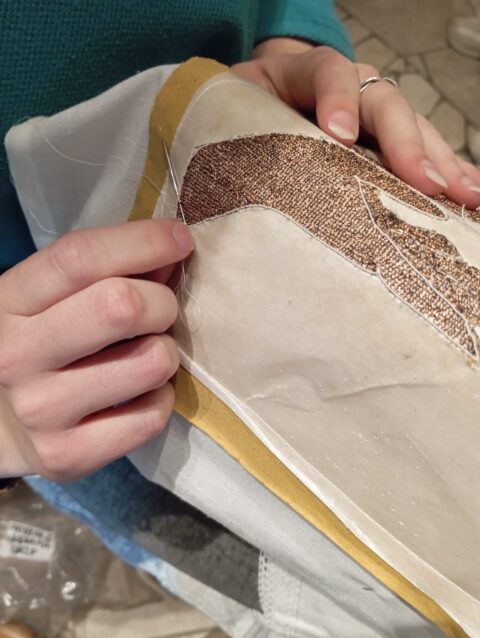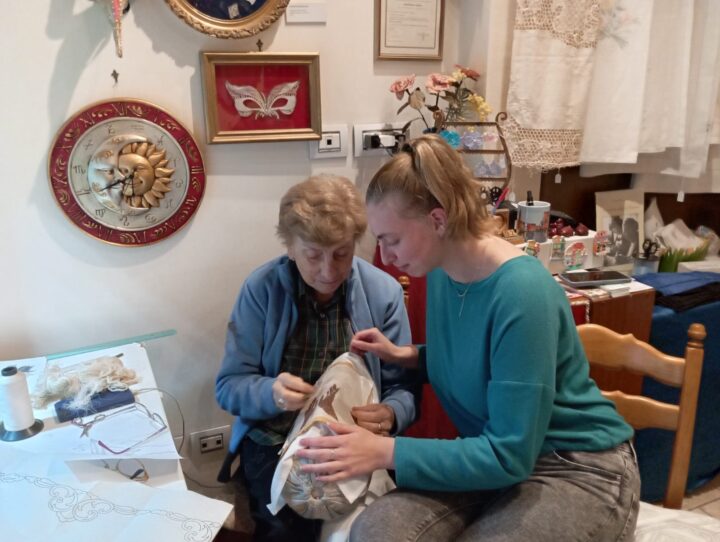Embroidering living heritages through the hand of a craftsmanship’s family
This text is the result of a collective reflection, and of dialogues between the very young artisan Ludovica Zane and the AGA team.
This dialogue stems from the desire, as part of the Living Heritage Journeys project, to listen some protagonists of the Venetian living heritage community. During the first LHJ workshop in Venice in 2024, the glass bead artisans—invited to participate as part of the Venetian intangible heritage community—told us about a young woman committed to passing on the heritage of embroidery and lace-making on the island of Burano. We were struck by the pride with which one artisan spoke of a very young daughter of an artist, a “figlia d’arte”. So, we contacted Ludovica.
A Family Heritage in the Burano Island: embodying memory
The passion with which young Ludovica talks about her family workshop is striking: a world of relationships, and of transmission from generation to generation, form grandmother to granddaughter.
We have often wondered about the meaning of this choice, which we now bring to the project: more than an individual artist, here we are witnessing the profound legacy of Italy's family workshops. An ancient model, deeply rooted in Italian social and economic reality, at the same time weakened by profound global transformations and the modern figure of the artist-individual, the Autor.
For Ludovica, memory isn't so much a conscious artistic choice, but an experience embedded in everyday life, in the world of relationships of which she is both daughter and heir. Working with her grandmother is a natural gesture, a necessity dictated by her learning process, but also a source of pride. Reflecting on how to visually convey the three games—s-cianco, Venetian rowing, and the To-vegna ball game—that are part of our pilot project, Ludovica and us considered how to give greater visibility to the humanity of the practices and movement. Looking for something that would unite the three games, the hand emerged. The hand of a man playing and rowing his boat across the lagoon. But also, the hand of a craftsman embroidering and weaving threads: a hand we want to continue using.

© Ludovica Zane
This is how Ludovica talks about her experience:
First of all, by introducing the family business as a powerful safeguarding Living Heritage-model.
A Family Business: LA MERLETTAIA - Laguna FLA Group Srl
"Our company is focused on sustainability and was born from Massimiliano Zane's desire to preserve and promote Burano lace and the Venice lagoon, which have always lived in symbiosis.
Sandra Mavaracchio is one of the last master lacemakers, as well as the only one to hold the qualification of Master Craftsman in this field from the Veneto Region. Her son, Massimiliano, also holds the same title as a needle lace designer, acquiring these skills primarily by watching his mother create works of art from an early age. This ancient needlework tradition has been in our family for five generations, and now Grandma Sandra is teaching it to her granddaughters, especially Ludovica, who, at 19, is the youngest lacemaker.
Sandra is one of the few masters lacemakers able to carry out and teach all phases of the process, from the design to the finished product, and is the only one capable of repairing and restoring damaged works. This cultural and artistic heritage risks extinction if we don't intervene in the very short term. First, by creating a trademark to protect its originality and provenance, and then, at the same time, by transmitting, handing down, and, therefore, teaching this technique to as many people as possible, so that it doesn't get lost.
Secondly by presenting his experience of working with his grandmother, while communicating with the three communities of practitioners involved in the project: an experience of mind’s relationships."

© Ludovica Zane
Intangible relationships
During this experience, I was able to communicate with many people from diverse backgrounds, successfully combining their experiences with my and my grandmother's art.
We combined our minds, our years of experience, and our passion for the world we live and love; we managed to create a lace that unites different realities, bringing out the emotions and stories of people from the present and the past. It wasn't easy, but my grandmother and I are proud of the final result.
To describe the process that led to the creation of this work, we can say that it was necessary to research and study the realities of the games we needed to represent. This was followed by the design process, that is, trying to sketch out on paper what the games were. This step wasn't easy; the design had to be approved by us lacemakers before it could be realized, but above all, it had to appeal to the players of the games we were designing... it took a few weeks, but in the end, we managed to find a design that everyone would enjoy.
Then came the lace-making part, which was done by my grandmother and I: it was fun for both of us because we passed the pillow with the work back and forth whenever one of us was free. Finally, once the lace was attached to the linen, we moved on to the embroidery part. We decided to create small blue waves that would evoke the thread that unites all games, but also the reality of the lagoon, the reality in which Burano lace and Venetian rowing live. The embroidery was done by my grandmother; since she has more experience than I do, we decided on the type of embroidery together, and then she finished it.
As mentioned, we are proud of the result. We hope this work fully represents the realities of play and life entrusted to us, and we also hope it will inspire people to try these games, as well as to try their hand at the arts of embroidery.
From the hands of the embroiderer and the lacemaker, from the waves of the lagoon, simple and universal tools emerge: the boat, the ball, the stick used in the game of lippa. Objects present in cultures throughout the world, whose extraordinary simplicity and diffusion reminds us of the foundations of our humanity.